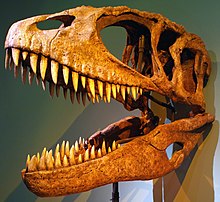Carcharodontosauridae
| Carcharodontosaurids Temporal range: Late Jurassic–Late Cretaceous,154–70 Ma |
|
|---|---|
 |
|
| Cast of a Carcharodontosaurus saharicus skull, Santa Barbara | |
| Scientific classification | |
| Kingdom: | Animalia |
| Phylum: | Chordata |
| Class: | Reptilia |
| Clade: | Dinosauria |
| Order: | Saurischia |
| Suborder: | Theropoda |
| Clade: | †Carcharodontosauria |
| Family: |
†Carcharodontosauridae Stromer, 1931 |
| Type species | |
|
†Carcharodontosaurus saharicus Deperet & Savornin, 1925 |
|
| Subgroups | |
|
|
| Synonyms | |
|
|
Carcharodontosaurids (from the Greek καρχαροδοντόσαυρος, carcharodontósauros: "shark-toothed lizards") were a group of carnivorous theropod dinosaurs. In 1931 Ernst Stromer named Carcharodontosauridae as a family, in modern paleontology this name indicates a clade within Carnosauria. Carcharodontosaurids included some of the largest land predators ever known: Giganotosaurus, Mapusaurus, Carcharodontosaurus, and Tyrannotitan all rivaled or slightly exceeded Tyrannosaurus in length. A 2015 paper published in PalArch by paleontologist Christophe Hendrickx and colleagues that focuses on the history of theropod dinosaur research gives a maximum length estimate of 14 meters (46 feet) for the largest carcharodontosaurids, while the smallest carcharodontosaurids were estimated at at least 6 meters (20 feet) long.
Along with the spinosaurids, carcharodontosaurids were the largest predators in the early and middle Cretaceous throughout Gondwana, with species also present in North America (Acrocanthosaurus), and Asia (Shaochilong). Their ages range from the Barremian (127-121 million years ago) to the Turonian (93-89 million years ago). Past the Turonian, they might have been replaced by the smaller abelisaurids in Gondwana and by tyrannosaurids in North America and Asia. According to Fernando Novas and colleagues, the disappearance of not only carcharodontosaurids but also spinosaurids and other fauna in both Gondwana and North America seem to indicate that this faunal replacement occurred on a global scale. However, some theropod teeth discovered in late Maastrichtian Marília Formation in Brazil, as well as a fragment of right maxilla discovered at the Campanian-Maastrichtian boundary of the Presidente Prudente Formation in Brazil, appear to belong to carcharodontosaurids, indicating the survival of this group until the latest Cretaceous. In December 2011, Oliver W. M. Rauhut described a new genus and species of carcharodontosaurid from the Late Jurassic (late Kimmeridgian to earliest Tithonian faunal stage, about 154-150 million years ago) of Tendaguru Formation, southeastern Tanzania. Veterupristisaurus represents the oldest known carcharodontosaurid.
...
Wikipedia
